The digital age has made email one of the most effective and influential forms of marketing. With the right strategy, email marketing can be a powerful tool for businesses of all sizes, providing an efficient and cost-effective way to reach customers and prospects. There are a variety of different types of email marketing, each with their own unique advantages and disadvantages. In this blog post, we’ll explore the different types of email marketing and their benefits. I will provide as well examples of successful campaigns.
Newsletter Emails
These are regular emails that are sent to keep subscribers up to date on company news and offers.
Newsletter emails are an integral part of digital marketing. They enable businesses to reach their customers directly, allowing them to stay informed about company news, promotions, and special offers. They can also be used to provide customers with helpful information, such as product reviews, industry trends, and educational material.
Additionally, they are an effective way to build relationships with customers, as they allow companies to communicate directly with them. Newsletter emails are usually sent on a regular basis, such as weekly or monthly.
They should contain a consistent design, with a clear call-to-action and eye-catching visuals. It’s also important to ensure that the content is relevant to the subscribers, as this will increase the chances of them engaging with the email.
Finally, newsletter emails should include clear opt-out instructions, as this will ensure that customers are able to unsubscribe if they no longer wish to receive the emails.
Newsletter Emails Examples
Contentful
This newsletter from Contentful provides readers with a valuable resource for improving their content operations. The newsletter includes a link to a recent blog post, which provides readers with up-to-date information on the latest trends and best practices in content management. Additionally, readers are informed of a new feature they can try to maximize the content operations process. Finally, the newsletter provides educational materials on how to improve content operations, making it a great resource for anyone looking to optimize their content management.

Asana
This newsletter from Asana provides useful advice and information to help people better use their product. It includes 6 ideas on how to improve team collaboration, a protip on how to better use the tool, and a video on what’s new in Asana. This is an effective way for Asana to stay connected with its users and to increase brand awareness. It also provides users with the resources they need to get the most out of their product.

Automated Emails
These emails are triggered by subscriber actions and can be sent at specific times or intervals.
Automated emails are emails that are triggered by specific subscriber actions, such as signing up for a newsletter, purchasing a product, or requesting a service. They are sent at specific times or intervals, usually based on the subscriber’s activity.
Automated emails are typically used to send personalized messages and offers to customers and prospects, to keep them informed and engaged with a company’s brand.
To learn more about how brands are leveraging email marketing to achieve their goals, check out our blog post, Why Are Brands Fully Embracing Email Marketing?
Automated emails can also be used to notify customers of updates and new releases, or to thank them for their business.
This type of emails can even be used to send out targeted promotions and discounts, to help build loyalty and encourage repeat purchases. By automating these emails, businesses can save time and resources, and ensure that their customers receive the most relevant and timely information.
Automated Emails Examples
Nike
This automated email from Nike is an effective way to engage customers on their birthday. It includes a cheerful greeting, a 10% discount on their next order, and a reminder that shipping is free. This email can help to encourage customers to make a purchase, as well as to show appreciation for their loyalty.

Mention
This automated email from Mention is a great way to follow up with customers who have recently completed a free trial of their product. The email asks the customer how useful Mention was during their trial, giving them the opportunity to provide feedback and share their experience. Overall, this automated email is a great way for Mention to gain valuable insights and further develop their product.

Welcome Emails
These are special emails sent to welcome new subscribers to your mailing list. They typically include an introduction to the company, an explanation of the benefits of subscribing to emails, and an incentive or discount code to encourage further engagement.
Welcome emails are a great way to build relationships with new subscribers and start off on the right foot. They allow you to introduce yourself, personalize the conversation, and provide helpful resources for the new subscriber to learn more about your company and the value it can bring.
Welcome emails are an opportunity to show off your brand’s personality and introduce subscribers to the features, benefits, and advantages of subscribing to your email list. You can use welcome emails to provide subscribers with a better understanding of what they can expect from your emails, such as promotional offers, exclusive content, discounts, and other incentives.
In addition, welcome emails are a great way to get subscribers to take action right away. You can encourage them to complete their profile, follow you on social media, or take advantage of an exclusive offer.
Welcome emails can also be used as an opportunity to build trust and establish credibility in the eyes of new subscribers. By including testimonials and reviews from customers, you can quickly demonstrate the value that you bring to the table.
Overall, welcome emails are an essential part of any email marketing strategy. They are an opportunity to make a great first impression, set the tone for your relationship, and get subscribers engaged with your brand.
Welcome Emails Examples
GoDaddy
This welcome email from GoDaddy is a great way to introduce new customers to their services. By offering a 30% off promo code, customers can save money on their services while learning more about building a website. The email also includes helpful links to resources on how to find a domain name and how to create a website, making it easier for customers to get started with their online presence.

Canva
The welcome email from Canva provides users with an introduction to the design tool and encourages them to start creating. It reassures users that they do not need any design experience to use the tool, and that they can design anything with Canva. The email also includes a “Create designs” button which takes the user directly to the platform, making it easy to start designing right away. Overall, the welcome email is an effective way to introduce users to the design tool and encourage them to give it a try.
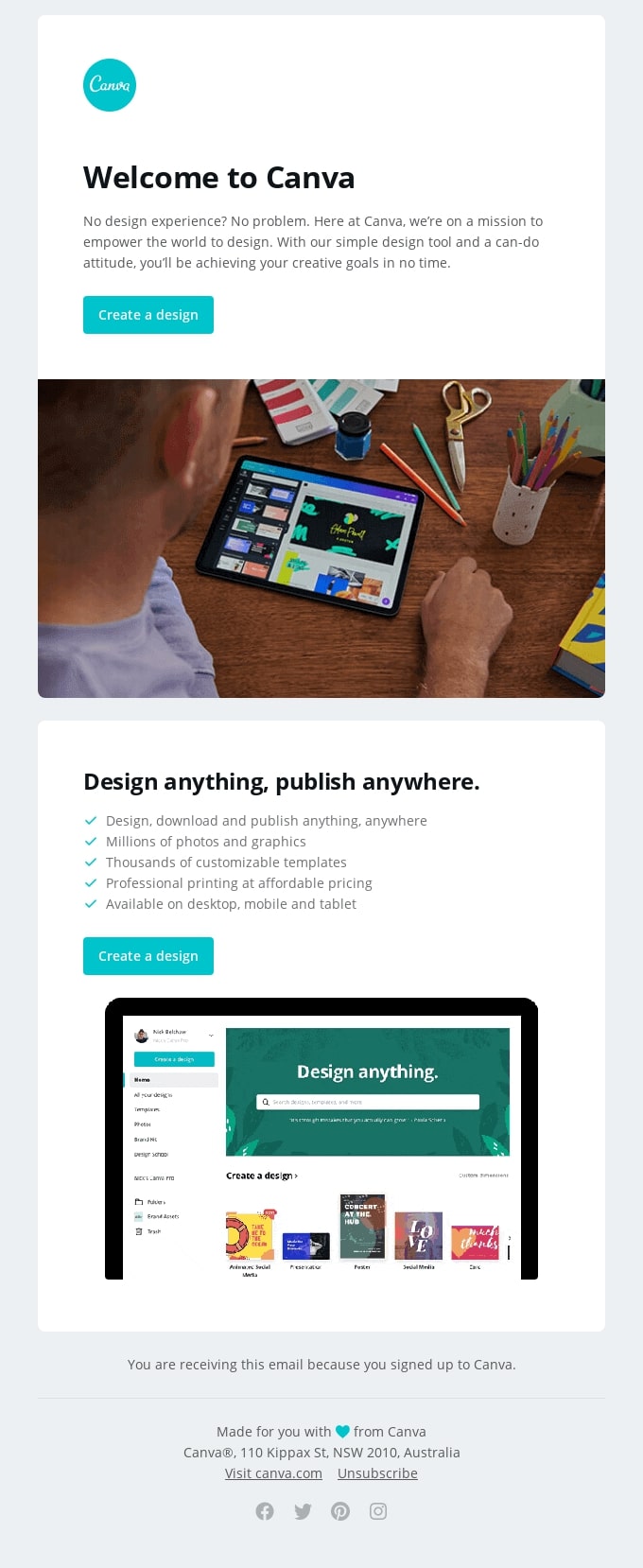
Transactional Emails
These are triggered by a customer’s purchase and can include order confirmations, shipping notifications, and more.
Transactional emails are emails triggered by a customer’s purchase or action. These emails are sent to customers to provide information about their transaction, such as order confirmations, shipping notifications, and invoices.
They can also be used to provide customers with helpful product information and updates. Additionally, transactional emails can be used to deliver promotional material, such as discount codes and special offers.
By utilizing transactional emails, businesses can engage with customers in an automated, personalized and highly effective way.
Transactional Emails Examples
Tropicfeel
This transactional email from Tropicfeel is designed to thank customers for their order and provide them with an estimated delivery date. It also encourages customers to spread the word about their products by sharing their experiences on social media. This helps to build brand awareness and engage with potential customers.

Dyson
This transactional email from Dyson is an effective way to remind customers of items they have left in their cart and prompt them to complete the purchase. The email includes a clear call to action button to continue shopping, as well as a list of the items in the basket and their prices. Additionally, the email highlights the benefits of shopping with Dyson, such as their 30-day money-back guarantee and free 2-day delivery, to encourage customers to complete their purchase.

Lead Nurturing Emails
These emails focus on developing relationships with potential customers by providing helpful content.
Lead nurturing emails are a type of email marketing used to build relationships with potential customers. They are designed to provide helpful content that keeps people engaged and interested in your brand.
Lead nurturing emails focus on providing customers with relevant, timely, and valuable information that is tailored to their individual needs. Examples of lead nurturing emails include newsletters, educational content, product updates, special offers, customer success stories, webinars, and blog posts.
By providing customers with content that is relevant and meaningful to them, you can build trust and loyalty with your potential customer base. Lead nurturing emails are an effective way to keep potential customers engaged and interested in your brand, and eventually, convert them into paying customers.
Lead Nurturing Emails Examples
Grammarly
Grammarly’s lead nurturing email effectively highlights the benefits of their premium plans by offering a 40% discount. It also clearly outlines the difference between the free and premium plans, making it easy for potential customers to understand the value of upgrading their account. They also provide a clear call-to-action encouraging customers to take advantage of the discount and upgrade their plan.

Buffer
This lead nurturing email from Buffer provides potential customers with an opportunity to learn more about how to effectively use Buffer features to drive traffic to their website. Through registration for the live tutorial, potential customers can gain insight into how to best optimize the features offered by Buffer and how to improve their website’s visibility. By including this tutorial, Buffer is providing an opportunity for potential customers to become more informed and make an informed decision on whether or not to invest in their services.
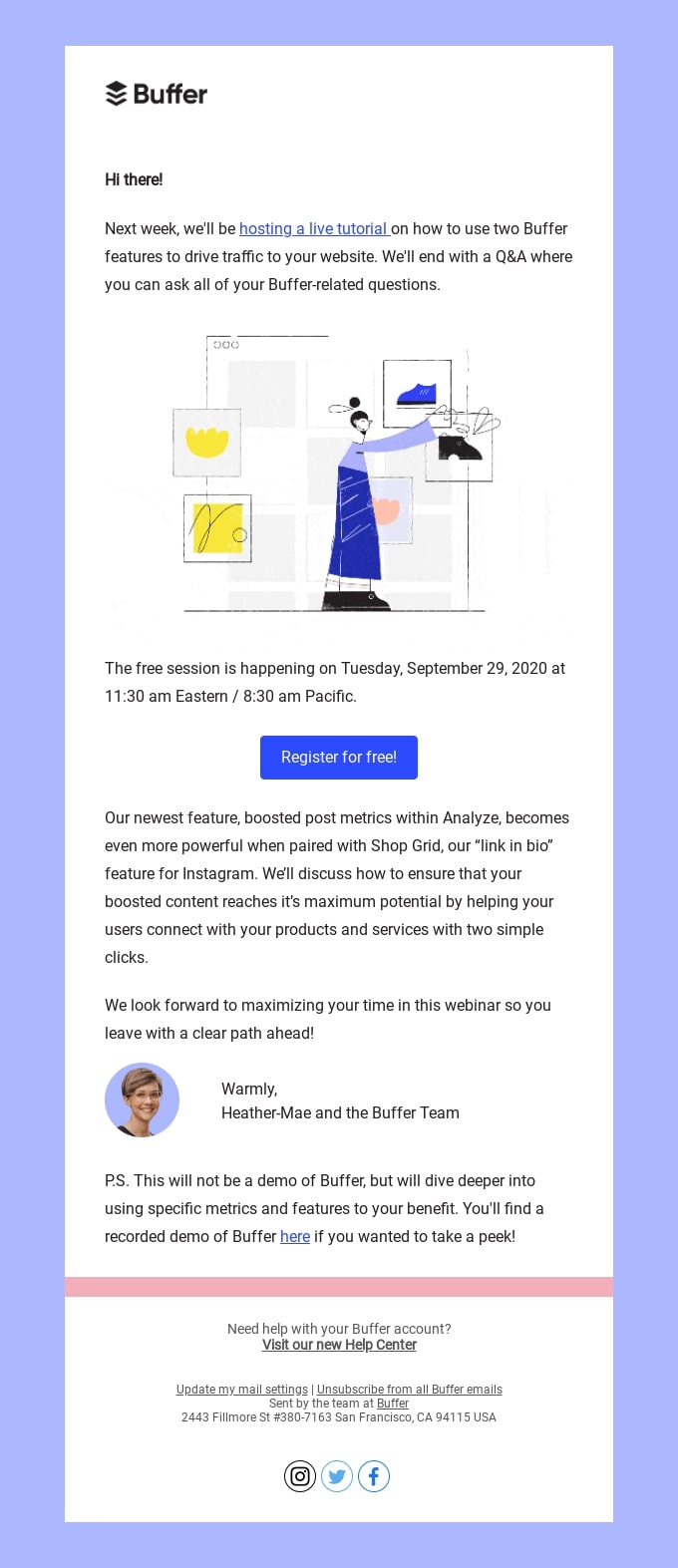
Content Promotion Emails
These emails are sent to promote content such as a blog post, article, or product.
Content promotion emails are an important piece of the marketing puzzle. They help you get the word out about your content and can be used to drive traffic, build relationships, and even generate leads.
These emails should be crafted with an understanding of your target audience, the goals of the content, and the best methods for promotion. Content promotion emails should be clear, concise, and engaging. They should include helpful information, such as a short overview of the content, links to the content, and an engaging call to action.
Content Promotion Emails Examples
Indeed
The content promotion email from Indeed provides a great overview of their latest blog article about “8 Resume Do’s and Don’ts”. The email also includes links to five other blog posts in order to provide the reader with more helpful resume advice. This email is a great way for Indeed to promote their blog and help people with their resumes.

Knak
This content promotion email from Knak is a great example of how to maximize the reach of your content. The email includes a main blog post about collaboration, two product updates, two other blog posts, and a section on how to use Knak with Pardot. This content is relevant and engaging, and provides valuable information to customers.

Product Updates Emails
These emails are sent to customers to update them on new products and services being offered.
Product updates emails are an important way to keep customers informed about the latest products and services that a company has to offer.
These emails can include information about any new features or changes that have been made to existing products, as well as any new products or services that have been launched. Additionally, these emails can include promotional offers, discounts, and other incentives to encourage customers to purchase the new products or services.
Product updates emails should also include helpful information about how customers can use the new products or services to benefit their business.
By keeping customers up-to-date on the latest products and services, companies can ensure that customers remain loyal and satisfied with their offerings.
Product Updates Emails Examples
Grammarly
This product update email from Grammarly announces that their software is now available for Microsoft Word. It provides a button to download the software and a brief description on how it works. This email is designed to inform those who are already familiar with Grammarly of the new feature, as well as introducing new users to the product. By providing a direct link to download the software, the email encourages quick and easy action from the recipient.

ClickUp
This product update email from ClickUp is designed to highlight recent product updates and invite users to a webinar to learn more. The email includes a list of new features, such as Hubspot Intgration, the new sharing modal, and their new public API website. Additionally, the email invites users to a webinar to see all the recent updates. This email is a great way for ClickUp to engage with their users and ensure they are up-to-date on the latest product updates.

Event Promotion Emails
These are used to promote upcoming events and can include discounts, registration links, and more.
Event promotion emails are an effective way to get the word out about upcoming events. They can include detailed information about the event, including dates, times, location, and registration information.
They can also include discounts or offers related to the event. Additionally, event promotion emails can provide links to relevant websites, social media accounts, or payment portals. Event promotion emails can also include images or videos related to the event that help give the reader an idea of what to expect.
Finally, they can include a call-to-action, such as a button that encourages the reader to register or buy tickets. By including all of this information, event promotion emails can help increase attendance and generate excitement for the event.
Event Promotion Examples
Adobe
The event promotion email from Adobe includes an invitation for users to register for a free virtual event. This email is likely intended to get more people to participate in the event, as well as to generate interest in Adobe’s products and services.
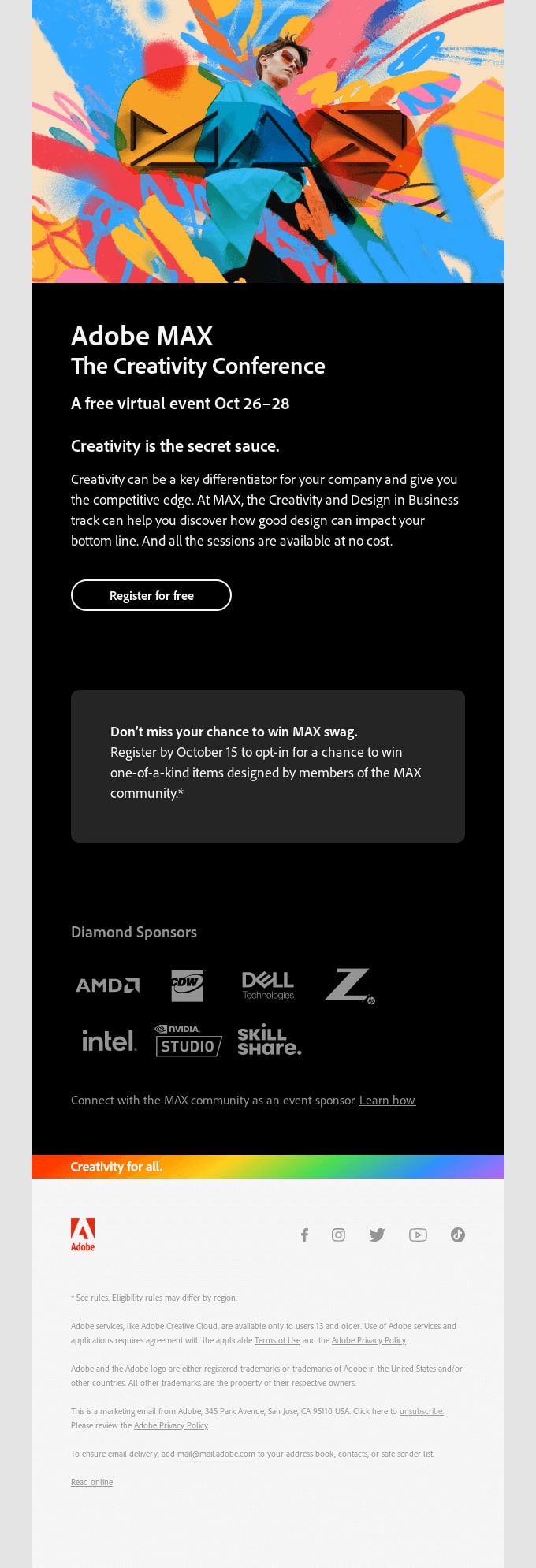
Slack
This event promotion email from Slack is an effective way to invite users to attend a free virtual event and learn how teams are using Slack to transform the way they work. The email provides an overview of the event and includes an easy-to-follow registration link for those interested in attending.
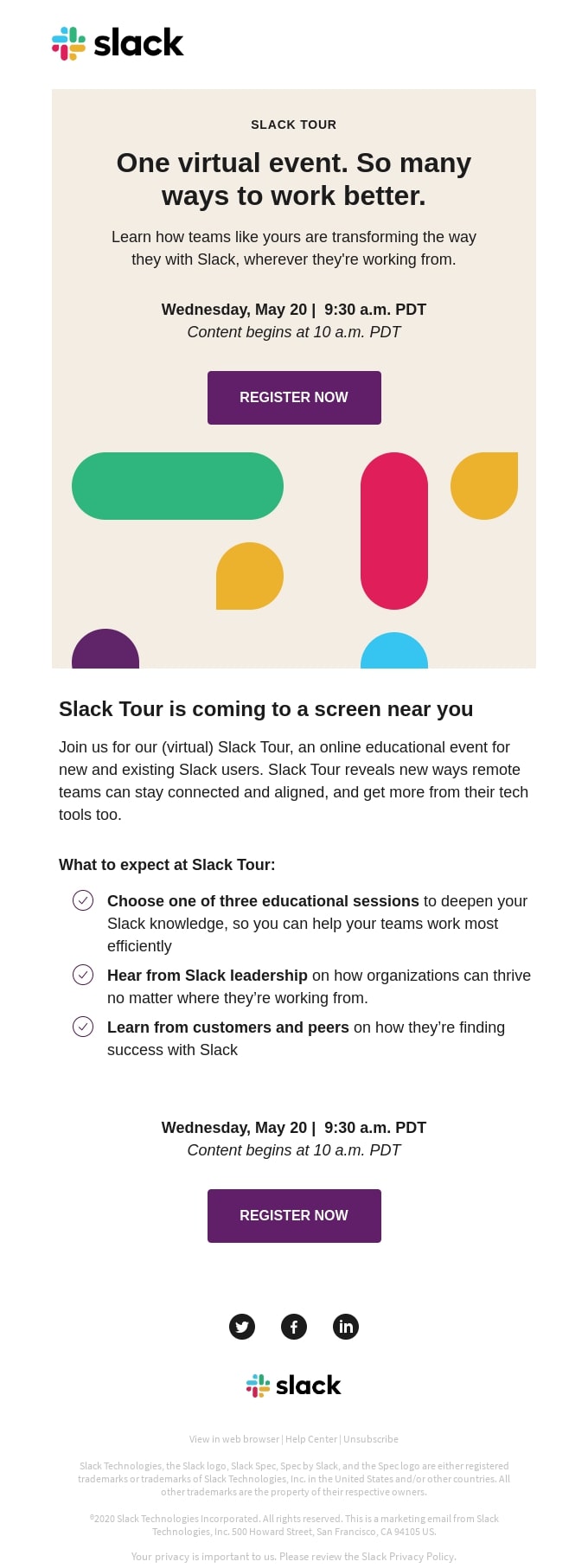
Re-Engagement Emails
These are used to re-engage inactive subscribers or to keep customers engaged with your brand.
Re-engagement emails are an effective way to reconnect with inactive subscribers and keep them engaged with your brand. They are typically sent to those who haven’t opened or clicked through any emails from you in a while. They can remind people of the value they receive from your brand and entice them to take action.
Re-engagement emails can include a variety of content, such as:
- A special offer or discount
- A link to a blog post or article
- A sneak peek of new products or services
- A reminder of an upcoming event
- A chance to win a prize or contest
- A personalized message that shows customers you care
- Exclusive content or early access to sales
These emails should be tailored to the individual customer and should be used sparingly to ensure your subscribers don’t feel overwhelmed or unappreciated. Additionally, be sure to include a clear call-to-action (CTA) that encourages people to interact with your brand. This can help to increase engagement and conversions.
Re-Engagement Emails Examples
Zapier
This re-engagement email from Zapier is designed to persuade dormant users to upgrade to a paid plan. It provides a strong incentive with a 30% discount and further emphasizes the value of the upgrade by listing four features that the user will gain access to. These features include access to premium apps, the ability to create multi-step zaps, add logic to the workflows, and a higher task limit. This email is effective in providing an attractive offer and clearly outlining the benefits of upgrading to a paid plan.
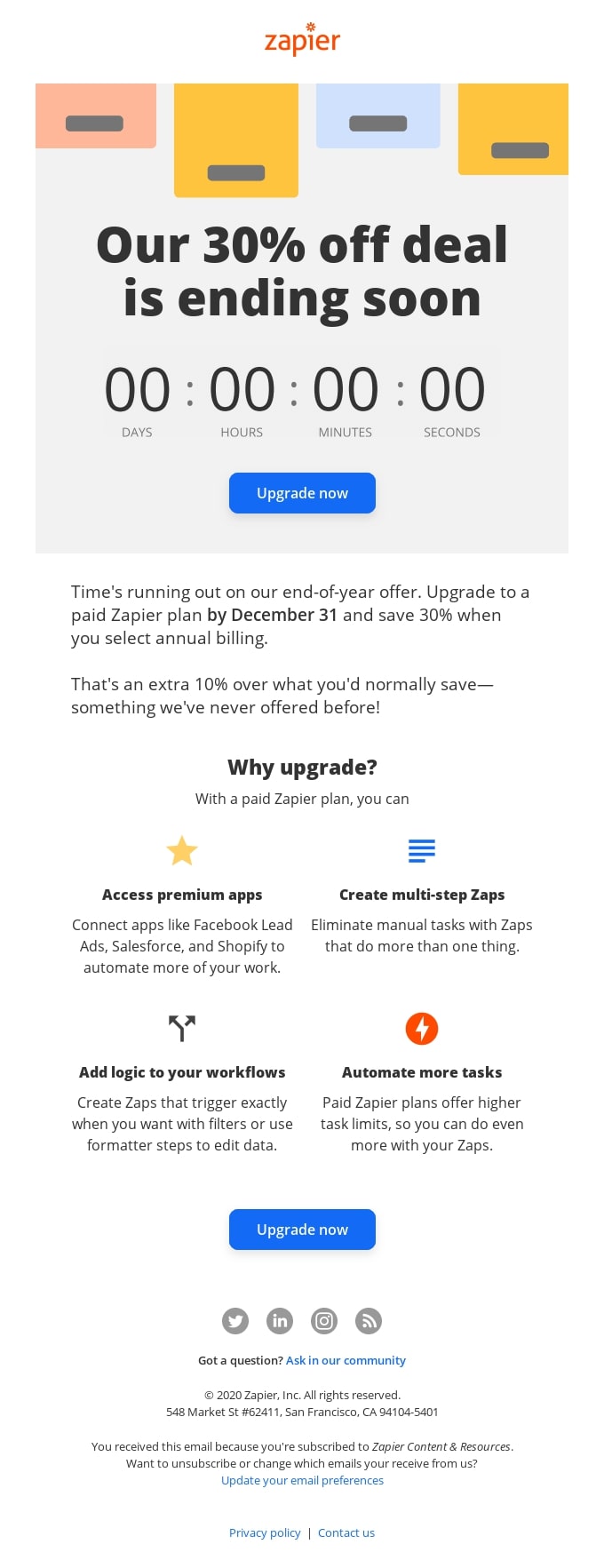
Dropbox
This re-engagement email from Dropbox Paper is designed to encourage users to give the tool another try. It includes a link to the template gallery, which provides a variety of templates that users can use to get started quickly and easily.
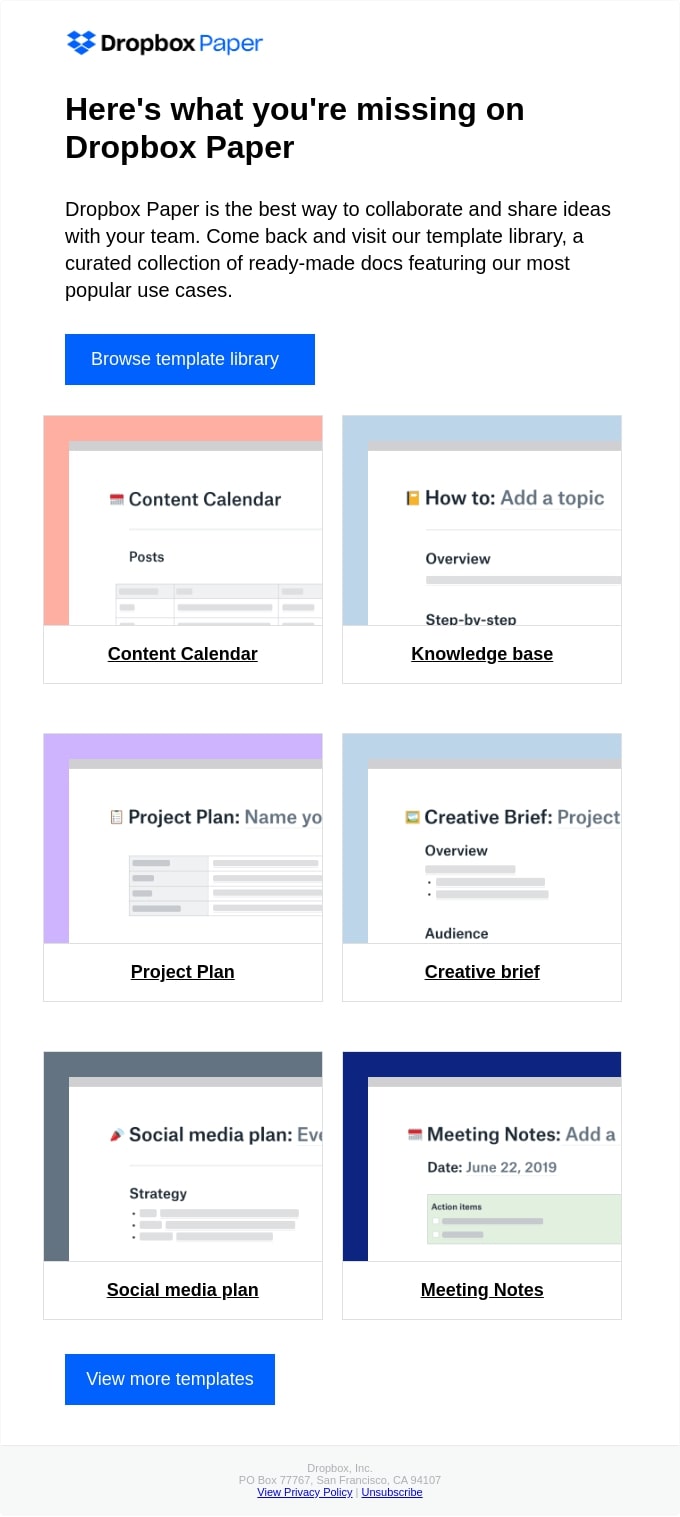
Referral Emails
These emails encourage existing customers to refer others to your products or services.
Referral emails are a great way to leverage the power of word-of-mouth marketing. They are designed to incentivize existing customers to refer their friends, family, and colleagues to your products or services. A referral email is typically sent out to existing customers, asking them to help spread the word about your business.
To create an effective referral email, you should clearly explain what the customer will get in return for referring someone. This could be a discount, a free trial, or something else that will appeal to them. You should also provide them with easy-to-follow instructions on how to refer someone, as well as a link to share with potential customers.
When creating referral emails, you should also consider including a personal note, thanking the customer for their support and expressing your appreciation for them. This can help build trust and increase the likelihood that they’ll refer someone.
Finally, you should keep track of who referred whom and reward those who successfully refer customers. This will help encourage customers to continue referring others, maximizing the effectiveness of your referral program.
Referral Emails Examples
Airbnb
This referral email by Airbnb is designed to encourage existing customers to invite their friends to join the platform. By offering a $30 free travel ticket to both the existing customer and the friend they refer, Airbnb is providing a strong incentive for customers to spread the word about their services. This type of promotion not only serves to grow the customer base, but also helps to foster loyalty among existing customers by rewarding them for their referrals.
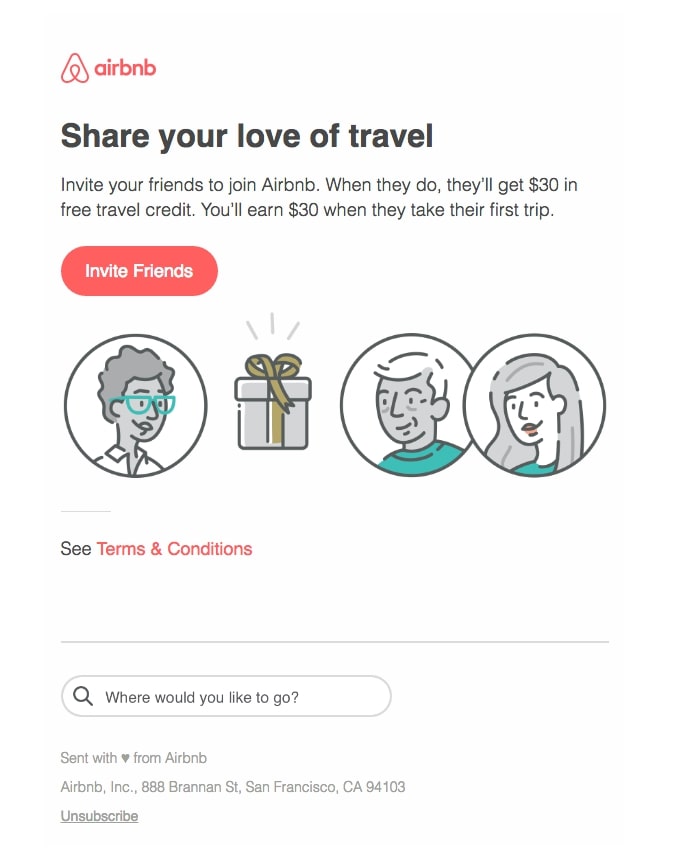
Coinbase
The referral email from Coinbase includes an incentive to refer a friend by offering $10 worth of Bitcoin to both the referrer and the referred friend. This referral program is a great way to incentivize people to join Coinbase and use their services, as well as to reward existing users for recommending Coinbase to their friends. This referral program is a win-win situation, as Coinbase will gain more users and both the referrer and the referred friend will receive $10 worth of Bitcoin.
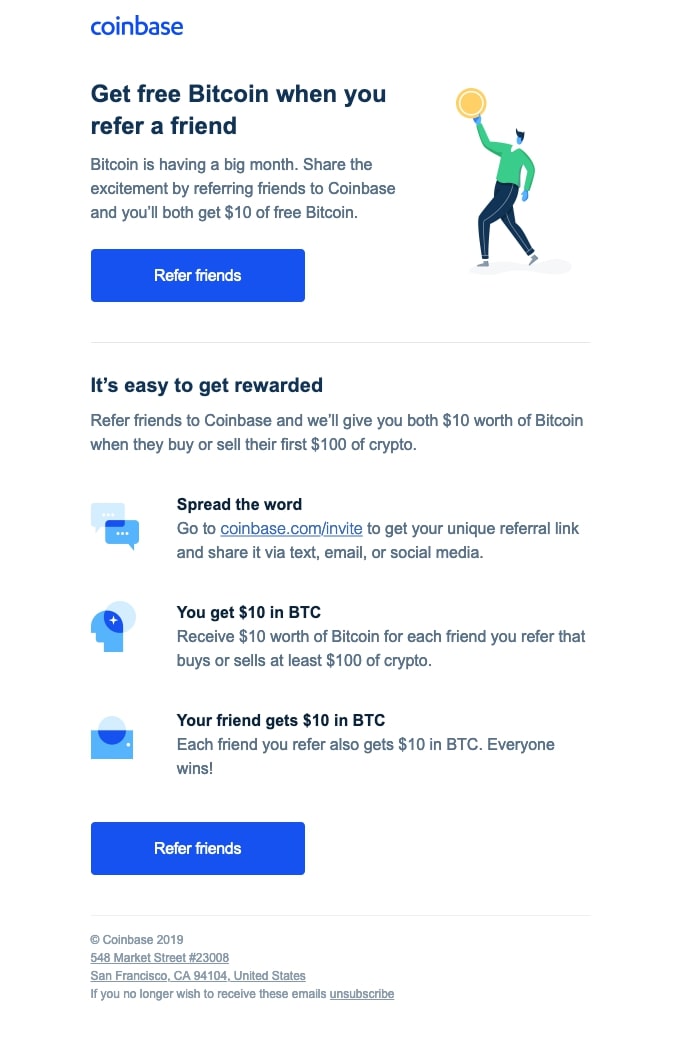
Conclusion
In conclusion, email marketing is a versatile and effective tool for businesses of all sizes. By understanding the different types of email marketing campaigns and their unique benefits, you can craft a successful strategy that helps you connect with your audience and drive conversions.
